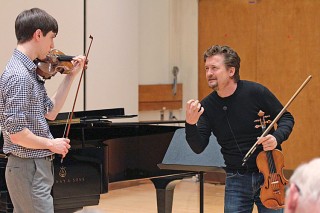Title

Christian Tetzlaff (right) worked with Juilliard violinists, including master’s student Wyatt Underhill, at his March master class.
(Photo by Peter Schaaf)"Imagine Mozart writing this stupid tune,” Christian Tetzlaff joked about a passage in the opening movement of the composer’s Fifth Violin Concerto. “There is nothing of ‘high art’ here.” Tetzlaff was urging fourth-year violinist Chelsea Smith, who was working with pianist Eduard Laurel, to play with a bit gutsier sound, better suiting the melody’s borderline silliness. This kind of candid, humorous—and ultimately helpful—advice was in evidence everywhere during a three-hour master class on March 25 with the renowned violinist.
Body
Five superb student violinists, with five discreetly attentive pianists, showed their skills in excerpts from well-known sonatas and concertos, all under Tetzlaff’s careful eye. Though the violinists couldn’t have been more different—as were the works they chose—as the evening progressed, a number of similar conclusions could be drawn from the master’s comments.
Musicians perform better when they relax and are able to breathe with the music. The word “freedom” kept recurring in Tetzlaff’s comments. He advised master’s student Rebecca Anderson (in the first movement of Brahms’s First Sonata, with master’s student Xiaohui Yang at the piano) to be “more sweeping, totally generous … as if the bow wants to go on after you change direction.” When Anderson repeated the passage, her sound was noticeably more spacious. Master’s student Wyatt Underhill (with pianist Hannah Sun, B.M. ’11, M.M. ’13) dug into the Allegro molto appassionato of the Mendelssohn Violin Concerto, and Tetzlaff encouraged him to “invite the audience in,” with his head up, his shoulders pivoted to the front, and with a more fluid bowing elbow. And “a little more joyful liberation in the bow arm” was the violinist’s advice to master’s student Fabiola Kim (with master’s pianist Alan Woo) in excerpts from the first movement of Beethoven’s Third Violin Sonata.
Instrumental color was another one of Tetzlaff’s concerns. He asked Anderson to change her finger pressure on a string just slightly, to give more presence to her pizzicato. “It’s more about the length and depth of sound, rather than the pluck itself,” he said. Later, trying to elicit a more leggiero tone, he described Brahms as “someone who composed a shiver.” Underhill received some fascinating wisdom that could apply to almost any player, anywhere: “Find something enticing in that note.” In the opening movement of Bartók’s Second Violin Concerto, B.C.J. student Erika Mitsui (with pianist Evan Solomon) was encouraged to appreciate more of the unusual timbres. At one point Tetzlaff noted, “There is almost a comic feeling to the harmonies.” Describing a line creeping up and down in minor seconds, he added, “Bartók is mixing two themes, as if a film director is editing them in the wrong order. Remember how strange this music is!”
Tetzlaff also acknowledged the relationship of music to speech, and encouraged students to think carefully about accents and phrasing. During Smith’s Mozart, Tetzlaff mentioned that in German and English, both of which often have unstressed syllables at the end of phrases, the final note is often softer than some people realize. (Think of iambic pentameter in English.) After hearing Mitsui’s Bartók, Tetzlaff noted how similar the colors are to the inflections that appear when people talk. Even shouting has gradations, he commented. In one passage in Kim’s Beethoven, Tetzlaff noted the four different fortissimos.
After Tetzlaff thanked Kim, he said, “Now I need some measures of the slow movement, so I can sleep better.” He wasn’t referring to her artful playing, only to the after-effects of Beethoven’s glorious writing, but he got a final well-deserved laugh anyway.




